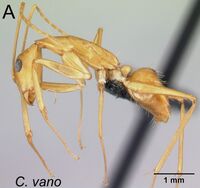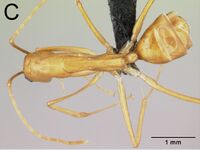Camponotus vano
| Camponotus vano | |
|---|---|

| |
| Scientific classification | |
| Kingdom: | Animalia |
| Phylum: | Arthropoda |
| Class: | Insecta |
| Order: | Hymenoptera |
| Family: | Formicidae |
| Subfamily: | Formicinae |
| Tribe: | Camponotini |
| Genus: | Camponotus |
| Subgenus: | Myrmosaga |
| Species: | C. vano |
| Binomial name | |
| Camponotus vano Rakotonirina & Fisher, 2022 | |
A species endemic to Madagascar, C. vano is geographically restricted to the PN Zahamena and the Corridor Forestier Analamay-Mantadia in humid forests in the east of the island. Collection data indicate that the species is arboreal; nests have been found in dead bamboo on the ground, while workers have been found foraging on lower vegetation.
Identification
Rakotonirina and Fisher (2022) - Lateral cephalic margins approximately parallel in full-face view; two apical teeth of mandibles closely spaced; lateral cephalic margin posterior to eye level without erect hairs; antennal scape covered with appressed hairs; mesosoma very low and long; propodeal dorsum at least four times as long as declivity; petiole nodelike.
See Camponotus radamae for additional details.
Keys including this Species
Distribution
Distribution based on Regional Taxon Lists
Malagasy Region: Madagascar (type locality).
Distribution based on AntMaps
Distribution based on AntWeb specimens
Check data from AntWeb
Countries Occupied
| Number of countries occupied by this species based on AntWiki Regional Taxon Lists. In general, fewer countries occupied indicates a narrower range, while more countries indicates a more widespread species. |

|
Estimated Abundance
| Relative abundance based on number of AntMaps records per species (this species within the purple bar). Fewer records (to the left) indicates a less abundant/encountered species while more records (to the right) indicates more abundant/encountered species. |

|
Biology
Castes
Nomenclature
The following information is derived from Barry Bolton's Online Catalogue of the Ants of the World.
- vano. Camponotus vano Rakotonirina & Fisher, 2022: 176, figs. 19B, 77 (s.w.) MADAGASCAR.
- Type-material: holotype worker (caste not indicated), 1 paratype major worker, 2 paratype minor workers.
- Type-locality: holotype Madagascar: Toamasina, PN Zahamena, Onibe River, -17.75908, 48.85468, 780 m., 22.ii.2009, BLF22341 (B.L. Fisher & Malagasy Arthropod Team); paratypes with same data.
- Type-depositories: CASC (holotype); CASC, PBZT (paratypes).
- Distribution: Madagascar.
Unless otherwise noted the text for the remainder of this section is reported from the publication that includes the original description.
Description
Worker
Morphological measurements: see Appendix 1 and Ratios of morphometric data for majors and minors
Minor With head in full-face view, lateral margins anterior to eye level parallel, posteriorly rounding evenly towards a rear margin that is somewhat necked; eye protruding and large (EL/CL: 0.29), breaking lateral cephalic margin, location of its posterior margin at posterior 1/3 of head (PoOc/CL: 0.34); frontal carinae widely opened (FR/CS: 0.29±0.00; 0.29–0.30), posteriorly parallel; clypeus with blunt or poorly defined anterolateral angle, anteromedian margin broadly convex; two apical teeth of mandible closely spaced; antennal scape relatively long (SL/CS: 1.68±0.03; 1.66–1.70). Mesosoma low and long (MPH/ML: 0.29±0.02; 0.28–0.31), promesonotum slightly convex, mesonotum and propodeum more or less flat; metanotal groove feebly visible, propodeal dorsum rounding to declivity, propodeal dorsum four times as long as declivity. Petiole nodelike, with dorsal margin inclined posteriorly and rounding to anterior margin; tibia of hind leg rounded axially, without basal twist.
First and second gastral tergites without a pair of white spots; erect hairs on lateral margin of head present anterior to eye level and absent behind eye level; posterior margin of head with two erect hairs; antennal scape covered with appressed hairs; junction of propodeal dorsum and declivity with a pair of erect hairs.
Major Differing from minor worker in the following characters: enlarged, elongate, and rectangular head (CS: 1.67; CWb/CL: 0.64) with slightly concave posterior margin; two apical teeth of mandible normally spaced; distal 1/3 of antennal scape surpassing posterior cephalic margin; robust, short, and high mesosoma, metanotum distinctly visible, propodeal dorsum almost 3 × as long as more vertical declivity, their junction forming a blunt angle; with more pairs of erect hairs. Head dark brown, body color pale brown, propodeum much darker.
Type Material
- Holotype worker. MADAGASCAR: Province Toamasina: PN Zahamena, Onibe River, -17.75908, 48.85468, 780 m, rainforest, beating low vegetation, 22 Feb 2009 (B.L. Fisher, Malagasy Arthropod Team) collection code: BLF22341, specimen code: CASENT0217316 (CAS).
- Paratypes. 2 minor workers and 1 major worker with same data as holotype but respectively specimen coded as: CASENT0077651, CASENT0840785, CASENT0152085 (PBZT, CAS).
Etymology
The species name vano is a non-Latin singular noun used in apposition and refers to the Malagasy name for “heron”. It refers to the elongate body form of the species.

